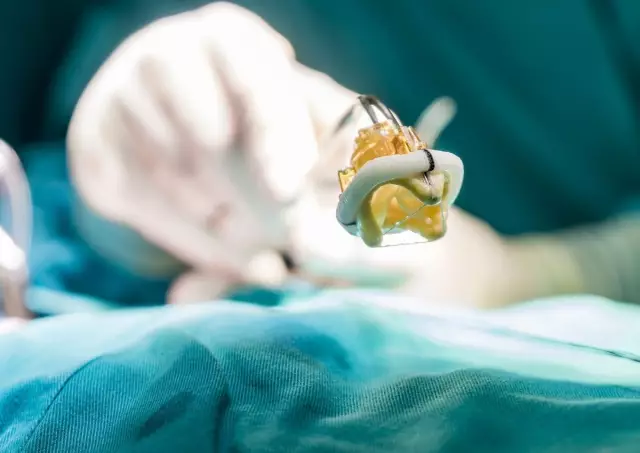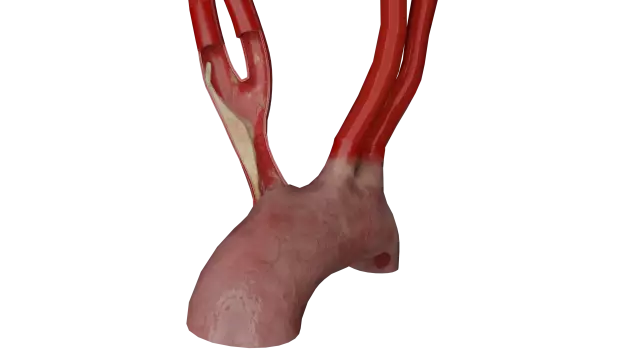- Author Rachel Wainwright [email protected].
- Public 2023-12-15 07:39.
- Last modified 2025-11-02 20:14.
Aortic stenosis

Aortic stenosis, or stenosis of the aortic opening, is a congenital or acquired disease characterized by narrowing of the outflow tract of the left ventricle in the region of the aortic valve, which causes difficulty in the outflow of blood from the left ventricle, and also contributes to a sharp increase in the pressure gradient between the aorta and the ventricle.
Types and causes of aortic stenosis
There are three types of aortic stenosis:
- valvular (congenital or acquired);
- supravalvular (only congenital);
- subvalvular (congenital or acquired).
The main causes of acquired aortic stenosis are:
- atherosclerosis of the aorta;
- degenerative changes in the valves with their subsequent calcification;
- Rheumatic valvular disease (the most common cause of the disease)
- infective endocarditis.
Rheumatic disease of the valve leaflets (rheumatoid endocarditis) provokes the contraction of the valve leaflets, as a result, they become rigid and dense, which is the reason for the narrowing of the valve opening. Calcification of the aortic valve is often observed, which contributes to an even greater decrease in leaflet mobility.
With infective endocarditis, similar changes are observed, leading to the development of aortic stenosis. Systemic lupus erythematosus and rheumatoid arthritis are often the causes of the disease.
Atherosclerosis of the aorta is accompanied by severe degenerative processes, sclerosis, stiffness and calcification of the leaflets of the fibrous valve ring, which also contribute to the obstruction of blood outflow from the left ventricle.
Sometimes in elderly people, primary degenerative changes in the valve become the cause of aortic stenosis. This phenomenon is called "idiopathic calcified stenosis of the aortic opening."
Congenital aortic stenosis results from defects and abnormalities of the valve. In the later stages of the development of the disease, severe calcification joins the symptoms of aortic stenosis, which aggravates the course of the disease.

Thus, in all patients at a certain degree of aortic stenosis, regardless of the cause, there is a deformation of the aortic valve and pronounced calcification.
Symptoms of aortic stenosis
Depending on the degree of aortic stenosis, patients may not experience any discomfort for a long time, i.e. for a long time, the disease has no symptoms.
With a pronounced narrowing of the valve opening, patients begin to complain of the appearance of angina attacks, rapid fatigue and weakness during physical exertion, fainting and dizziness with a rapid change in body position, shortness of breath. In severe cases, asthma attacks (pulmonary edema or cardiac asthma) are a symptom of aortic stenosis.
Patients with isolated stenosis of the aortic mouth may experience complaints associated with the appearance of signs of right ventricular failure (heaviness in the right hypochondrium, edema). These symptoms of aortic stenosis occur with significant pulmonary hypertension caused by mitral valve defects in combination with aortic stenosis.
During a general examination of the patient, he has a characteristic pallor of the skin.
Diagnosis of aortic stenosis
The main methods of instrumental diagnosis of aortic stenosis are:
- ECG;
- X-ray examination;
- Echocardiography;
- Cardiac catheterization
Treatment of aortic stenosis
With severe aortic stenosis, drug treatment is usually ineffective. The only radical treatment is aortic valve replacement. Already after the onset of symptoms of the disease, the chances of surviving without surgery are sharply reduced. On average, patients after the onset of symptoms such as heart pain, signs of left ventricular failure, fainting, live no more than five years.
After the diagnosis of "aortic valve stenosis" is established, the patient must be recommended preventive measures against infective endocarditis.
With asymptomatic aortic stenosis, drug treatment is aimed at maintaining sinus rhythm, preventing coronary artery disease and normalizing blood pressure.
After the appearance of complaints, if it is impossible to carry out the operation, drug treatment is prescribed. So, in the presence of heart failure with the help of medicines, they try to eliminate stagnation in the pulmonary circulation by taking diuretics. However, their too active use can contribute to the development of excessive diuresis, hypovolemia and arterial hypotension. With systolic dysfunction of the left ventricle, Digoxin is prescribed as a symptomatic agent, especially with atrial fibrillation.
In aortic stenosis, vasodilators are contraindicated in the patient, as their use can lead to fainting. However, in severe heart failure, sodium nitroprusside may be administered carefully.
For congenital aortic stenosis in children, aortic balloon valvuloplasty can be used. This method allows to reduce the maximum transvalvular gradient by 65%, but mainly this technique requires reoperation over 10 years. Patients may develop aortic regurgitation after valvuloplasty.
The most effective treatment for aortic stenosis is surgical aortic valve replacement. Aortic valve replacement is indicated for severe aortic stenosis in the following cases:
- the presence of fainting, angina, or heart failure;
- in combination with coronary artery bypass grafting;
- combined with operations on other valves.
Surgical treatment of aortic stenosis significantly improves the patient's well-being and prognosis of survival. It can be successfully performed even in elderly patients without the risk of developing severe pathologies. For prosthetics, autografts, allogeneic prostheses, allografts, mechanical prostheses or porcine bioprostheses and bovine pericardial prostheses are used.
YouTube video related to the article:
The information is generalized and provided for informational purposes only. At the first sign of illness, see your doctor. Self-medication is hazardous to health!






